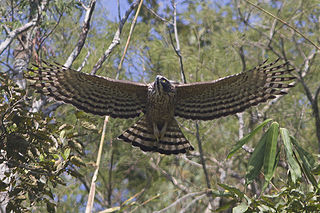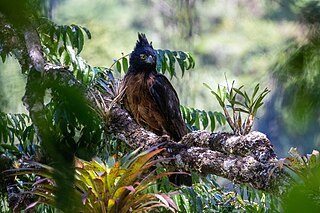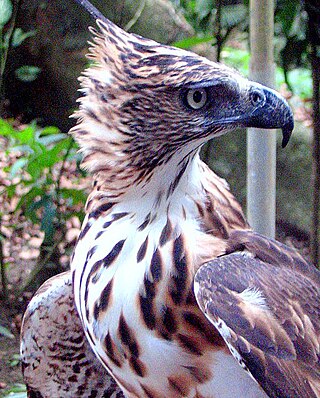
The changeable hawk-eagle(Nisaetus cirrhatus) or crested hawk-eagle is a large bird of prey species of the family Accipitridae. More informal or antiquated English common names include the marsh hawk-eagle or Indian crested hawk-eagle. It is a member of the subfamily Aquilinae, with signature feathers, absent in tropical raptors from outside this subfamily, covering the tarsus. It was formerly placed in the genus Spizaetus, but studies pointed to the group being paraphyletic resulting in the Old World members being placed in Nisaetus and separated from the New World species. It is a typical “hawk-eagle” in that it is an agile forest-dwelling predator and like many such eagles readily varies its prey selection between birds, mammals or reptiles as well as other vertebrates. Among the members of its genus, the changeable hawk-eagle stands out as the most widely distributed, adaptable and abundant species. Individuals show a wide range of variation in plumage from pale to dark, varying with moult and age giving rise to the name "changeable".

The mountain hawk-eagle or Hodgson's hawk-eagle, is a large bird of prey native to Asia. The latter name is in reference to the naturalist, Brian Houghton Hodgson, who described the species after collecting one himself in the Himalayas. A less widely recognized common English name is the feather-toed eagle. Like all eagles, it is in the family Accipitridae. Its feathered tarsus marks this species as a member of the subfamily Aquilinae. It is a confirmed breeding species in the northern part of the Indian subcontinent, from India, Nepal through Bangladesh to Thailand, Taiwan, Vietnam and Japan, although its distribution could be wider still as breeding species. Like other Asian hawk-eagles, this species was earlier treated under the genera of Spizaetus but genetic studies have shown this group to be paraphyletic, resulting in the Old World members being placed in Nisaetus and separated from the New World species. As is typical of hawk-eagles, the mountain hawk-eagle is a forest dwelling opportunistic predator who readily varies its prey selection between birds, mammals and reptiles along with other vertebrates. Although classified currently as a least-concern species due its persistence over a rather wide distribution, this species is often quite rare and scarce and seems to be decreasing, especially in response to large-scale habitat degradation and deforestation.

The rufous-bellied eagle or rufous-bellied hawk-eagle is a bird of prey in the family Accipitridae that is found in the forested regions of tropical Asia. Relatively small for eagles and contrastingly patterned like a falcon, this species was earlier placed in the genus Hieraaetus and sometimes also in the genus Aquila but thought to be distinctive enough to belong to a separate genus.

The coat of arms or national emblem of Indonesia is called Garuda Pancasila in Indonesian. The main part is the Garuda with a heraldic shield on its chest and a scroll gripped by its legs. The shield's five emblems represent Pancasila, the five principles of Indonesia's national ideology. The Garuda claws gripping a white ribbon scroll inscribed with the national motto Bhinneka Tunggal Ika written in black text, which can be loosely translated as "Unity in Diversity". Garuda Pancasila was designed by Sultan Hamid II from Pontianak, supervised by Sukarno, and was adopted as the national emblem on 11 February 1950.

The ornate hawk-eagle is a fairly large bird of prey from the tropical Americas. Formerly, some authorities referred to this species as the crested hawk-eagle, a name that may cause some confusion as it is more commonly used for an Asian eagle species. Like all eagles, it is in the family Accipitridae. This species has a feathered tarsus that marks it as a member of the Aquilinae or booted eagle subfamily. This species is notable for the vivid colors and bold markings of adults, which differ considerably from the far more whitish plumage of the juvenile bird. The ornate hawk-eagle ranges from central Mexico south through much of Central America and in a somewhat spotty but broad overall range into South America, including in the west apart from the Andes and broadly on the Atlantic side especially Brazil down to as far as Southeast Brazil and northern Argentina. This species is found largely in primary forests with tall trees, although can be found in many forest types.

The gray-headed kite is a raptor found in open woodland and swamp forests. It shares the genus Leptodon with the extremely rare white-collared kite. It breeds from eastern Mexico and Trinidad south to Peru, Bolivia, Brazil and northern Argentina.

Spizaetus is the typical hawk-eagle birds of prey genus found in the tropics of the Americas. It was however used to indicate a group of tropical eagles that included species occurring in southern and southeastern Asia and one representative of this genus in the rainforests of West Africa. The Old World species have been separated into the genus Nisaetus. Several species have a prominent head crest. These are medium to large-sized raptors, most being between 55 and 75 cm long, and tend to be long-tailed and slender.

Blyth's hawk-eagle is a medium-sized bird of prey. Like all eagles, it is in the family Accipitridae.

The Flores hawk-eagle is a large raptor in the family Accipitridae. It is an endemic species to the Lesser Sunda Islands in Indonesia. A member of the genus Nisaetus, it was considered as a subspecies of and conspecific with the changeable hawk-eagle but genetic studies have evidenced it as a legitimate species. A forest dwelling predator, this species is classified as Critically Endangered due to habitat loss and persecution.

The Sulawesi hawk-eagle, also known as Celebes hawk-eagle, is a medium-sized, approximately 64 cm (25 in) long, crestless brown raptor in the family Accipitridae. The adults have rufous-brown, boldly marked head and chest feathers, dark brown wings and black-barred white below. The young has white head and underparts.

The Congo serpent eagle is a species of bird of prey in the family Accipitridae. It is the only member of the monotypic genus Dryotriorchis, although it was formerly placed in Circaetus. This species is distributed across the African tropical rainforest, including upper and lower Guinean forests. This serpent eagle specializes in hunting in these forests’ dark understories. It has two subspecies, the nominate subspecies Dryotriorchis spectabilis spectabilis and Dryotriorchis spectabilis batesi. Though monotypic, it appears to be very closely related to Circaetus. This hawk is a medium-sized bird with distinctive short, rounded wings and a long, rounded tail. It is varying shades of brown on its back and has a slight crest. Its breast is white with variable amounts of a rufous wash and, in the nominate subspecies, is covered in round, blackish spots. The subspecies D. s. batesi only has these dots on its flanks. The Congo serpent eagle closely resembles Cassin's hawk-eagle, and some ornithologists believe that this likeness is a rare example of avian mimicry. It is a very vocal raptor, and often is one of the most heard species in its habitat.

The black-and-chestnut eagle, also known as Isidor's eagle, is a large South American species of bird of prey in the family Accipitridae. It is often placed in the monotypic genus Oroaetus. However, recent genetic testing indicates that this species is fairly closely related to Spizaetus species and thus the species should be included in that genus. The black-and-chestnut eagle is a typical forest raptor, hunting primarily small to medium-sized mammals and birds and constructing a large nest in a tall tree. Unfortunately, the twin causes of habitat destruction and persecution, justified or not as an occasional poultry killer, have caused strong population declines and the black-and-chestnut eagle is considered to be an Endangered species by the IUCN.

Cassin's hawk-eagle or Cassin's eagle, is a relatively small eagle in the family Accipitridae. Its feathered legs mark it as member of the Aquilinae or booted eagle subfamily. A forest-dependent species, it occurs in primary rainforests across western, central and (marginally) eastern Africa where it preys on birds and tree squirrels. It was named after John Cassin who first described it in 1865. Due to widespread habitat destruction, its populations are steadily declining but have not yet warranted upgrading its status from Least Concern.

The Philippine hawk-eagle or north Philippine hawk-eagle, earlier treated under Spizaetus, is a species of bird of prey in the family Accipitridae. Many taxonomists consider the Pinsker's hawk-eagle, a former subspecies, raised to full species status. It is endemic to the Philippines. Its natural habitat is tropical moist lowland forests. It is threatened by habitat loss and trapping.

The barred eagle-owl, also called the Malay eagle-owl, is a species of eagle owl in the family Strigidae. It is a member of the large genus Ketupa, which is found on most of the world's continents. This relatively little-known species is found from the southern Malay Peninsula down a string of several of the larger southeast Asian islands to as far as Borneo. It forms a superspecies with the physically similar but larger spot-bellied eagle-owl, although the two species appear to be allopatric in distribution.

Nisaetus, the crested hawk-eagles, is a genus of raptor in the subfamily Aquilinae, found mainly in tropical Asia. They were earlier placed within the genus Spizaetus but molecular studies show that the Old World representatives of that genus are closer to the genus Ictinaetus than to the New World Spizaetus. They are slender-bodied, medium-sized hawk-eagles with rounded wings, long feathered legs, barred wings, crests and usually adapted to forest habitats.

Legge's hawk-eagle is a bird of prey. Like all eagles, it is in the family Accipitridae. It breeds in the Indian subcontinent, from southern India to Sri Lanka. Its specific name kelaarti honors the physician-zoologist E.F. Kelaart.

The Aquilinae are a subfamily of eagles of the family Accipitridae. The general common name used for members of this subfamily is "booted eagle", although this is also the common name of a member of the subfamily. At one point, this subfamily was considered inclusive with the Buteoninae based probably on some shared morphological characteristics. However, research on the DNA of the booted eagles has shown that they are a monophyletic group that probably have had millions of years of separation from other extant forms of accipitrid.

Pinsker's hawk-eagle, south Philippine hawk-eagle or Mindanao hawk-eagle, is a species of bird of prey in the family Accipitridae. It is endemic to the Philippines native to the islands of Leyte, Samar, Negros, Basilan, Bohol and Mindanao. It is found in primary moist lowland forest and tropical moist montane forest up to 1,900 m. It is threatened by habitat loss and hunting. IUCN estimates just 600–800 mature birds left.




















